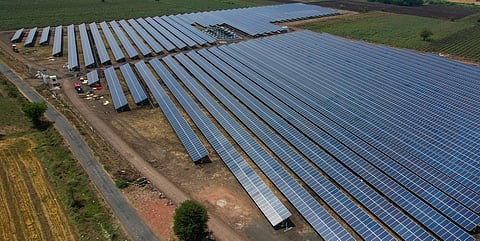

India has crossed a landmark in its energy journey, with non-fossil sources now accounting for more than half the country’s installed power capacity—five years ahead of its Paris Agreement commitments. But achieving a “Viksit Bharat” by 2047 will require tripling primary energy supply and scaling up non-fossil energy forty-fold, according to a new study released by the Confederation of Indian Industry (CII) and EY.
The report, Eigenvectors of Net Zero Energy Transition: Pathways to Viksit Bharat 2047, launched at the 6th International Energy Conference and Exhibition, stresses that India’s transition to net-zero by 2070 cannot be achieved by focusing on gigawatt additions alone. Instead, it must balance affordability, competitiveness, energy security and environmental health through a “human-centric” lens.
According to the report, India’s energy transition pipeline is already gathering scale, with projects worth nearly $105 billion currently under construction. These include renewable power generation and storage, solar PV manufacturing, battery supply chains, and bioenergy projects.
“This robust pipeline signals growing investor confidence and India’s ability to attract global capital into green infrastructure,” the report noted, adding that the platform will serve as a matchmaking hub between developers and financiers to accelerate the flow of funds into clean energy.
“India stands at a defining moment. Crossing 50 per cent non-fossil capacity ahead of schedule demonstrates our ambition, but the journey ahead is far more challenging,” said Chandrajit Banerjee, CII director general. “Our $30 trillion economy by 2047 will need three times more energy, and this must be met without compromising growth or sustainability.”
As of July 2025, renewable capacity stood at 188 GW, with solar contributing over 120 GW and wind about 50 GW. Including large hydro and nuclear, non-fossil sources reached 243 GW, out of a total 490 GW installed capacity.
Yet, renewables contribute less than 15 per cent of actual electricity generation, underscoring the challenge of integrating variable resources into the grid. The report calls for accelerating green energy corridors, repowering aging wind sites, and encouraging private investment in intra-state transmission.
The report also highlights the government’s Nuclear Energy Mission, which aims to expand nuclear capacity from 8.8 GW today to 100 GW by 2047. This includes small modular reactors (SMRs) and thorium-based technologies.
“Civil nuclear energy is finally moving from promises to a real value proposition,” the study notes, adding that nuclear will provide the base load stability needed to complement renewables while reducing import dependence.
However, it cautions that reforms to the Atomic Energy Act and Civil Liability for Nuclear Damage Act will be critical to unlocking private and foreign investment.
The Carbon Credit Trading Scheme (CCTS), operationalised in 2023 and amended in 2025, now covers 743 entities across eight sectors. It establishes both compliance and voluntary offset markets, aiming to transition from energy savings certificates to carbon credits by 2026.
“Building integrity in India’s carbon markets is vital for attracting global finance,” said Somesh Kumar, Partner and Leader, Power & Utilities at EY India. “Our findings show energy costs must remain competitive, imports secured, and environmental health uncompromised if India is to achieve a truly inclusive transition.”
The report frames the net-zero journey as a multidimensional optimisation problem, where policymakers must weigh affordability, security, and sustainability. It warns that focusing on single targets—like installed capacity or emissions cuts—ignores trade-offs such as import dependencies, technology disruptions, or air pollution impacts.
For instance, India’s exemption for certain coal plants from installing flue-gas desulphurisation in July 2025 reflected the balancing act between affordability and public health.
“Energy transition is not just about adding megawatts. It is about ensuring access, efficiency, affordability, and resilience for 1.5 billion people,” Banerjee stressed.
The study calls for synchronised transmission expansion, fast-tracking SMRs, enabling a circular economy for solar and battery waste, and strengthening carbon credit verification.
By prioritising these enablers, the report argues, India can unlock resilient growth, create jobs, and enhance global competitiveness while staying on track for its 2070 net-zero goal.
“Our approach distills complexity into clear directions,” Kumar said. “If India can balance ambition with pragmatism, disruptions with opportunities, the vision of a sustainable and prosperous Viksit Bharat 2047 is well within reach.”